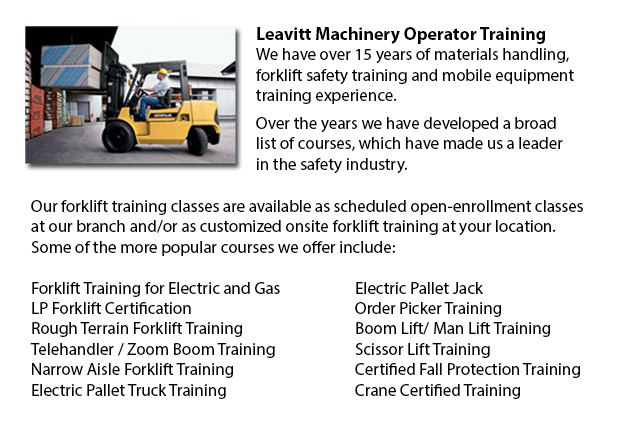
Forklift Training Schools Oakville - The Benefits Of Taking One Of Our Forklift Training Schools
If you are looking for a job as a forklift operator, our regulatory-compliant forklift training Schools offer excellent instruction in many types and styles of lift trucks, classes on pre-shift check, fuel kinds and handling of fuels, and safe utilization of a lift truck. Hands-on, practical training assists individuals participating in acquiring essential operational skills. Program content consists of current regulations governing the use of lift trucks. Our proven forklift courses are intended to offer training on these kinds of trucks: powered pallet truck, narrow isle forklift and counterbalanced forklift.
Do not raise or lower the fork when the lift truck is moving. A load must not extend higher than the backrest because of the risk of the load sliding back toward the operator. Check for overhead obstructions and ensure there is adequate clearance prior to lifting a load. Stay away from overhead power lines. When the load is lifted straight up, tilt it slightly back.
The lift truck is less stable when a load is in a raised position. Make certain that no one ever walks underneath the elevated fork. The operator must never leave the lift truck when the load is lifted.
The forks should be level when handling pallets, and high enough to extend all the way into and underneath the load. The fork's width must provide even distribution of weight.
Before unloading or loading the truck, chock the wheels and set the brakes. Floors should be strong enough to support the weight of the forklift and the load combined. Fixed jacks could be installed in order to support a semi-trailer which is not attached to a tractor. The entrance door height must clear the height of the forklift by at least 5 cm. Mark edges of docks, rail cars or ramps and avoid them.
-
Order Picker License Oakville
Order Picker License Oakville - Order preparation operation or order picking as it is more normally known is a method used within warehouse operations and consists of employees called order pickers. The order picker's task is to collect and take arti... More -
Forklift Operator Certification Oakville
Forklift Operator Certification Oakville - Forklift operator certification is normally needed for personnel working within industrial, warehouse or construction setting to guarantee the safe utilization of forklifts. Workplace training need to follow... More -
Scissor Lift Certification Oakville
Scissor Lift Certification Oakville - A lot of worksites and tradespeople like iron workers, welders and masons utilize scissor lift platforms to help them reach elevated work areas. The utilization of a scissor lift is usually secondary to their tra... More -
Forklift Training Courses Oakville
Forklift Training Courses Oakville - When forklift operator safety training is customized for illiteracy, training time is reduced by 50%. Train the trainer, forklift training certification and lift-truck operator driver safety training evaluation pr... More -
Manlift Training Oakville
Manlift Training Oakville - There are numerous manlift training programs which offer a review of the manlift machinery. The practicum portion of the training is one more vital portion of the course. In this section the trainee has chance to demonstra... More -
Boom Lift License Oakville
Boom Lift License Oakville - To operate an aerial boom lift, operators should be licensed through training that can be obtained utilizing both classroom sessions and practical training and by attaining a boom lift license. Instruction should be given... More -
Crane / Overhead Crane / Self-Erect Crane / Truck Mounted Crane / Hydraulic Cranes Training in Oakville
Bridge cranes or likewise called overhead cranes are actually a type of industrial material handling crane using a line and hook mechanism that runs on a horizontal beam running along two widely separated rails. Several overhead cranes could be seen... More -
Telehandler Training in Oakville
Telescopic handlers normally called telehandlers for short, are an extremely popular piece of heavy construction machinery. They are widely utilized in the construction and agricultural trades. These machines have maximum reaching ability and could g... More

Forklift Training Oakville
TOLL FREE: 1-888-254-6157
Oakville, Ontario
forklifttrainingoakville.com
Email Us
About Us


